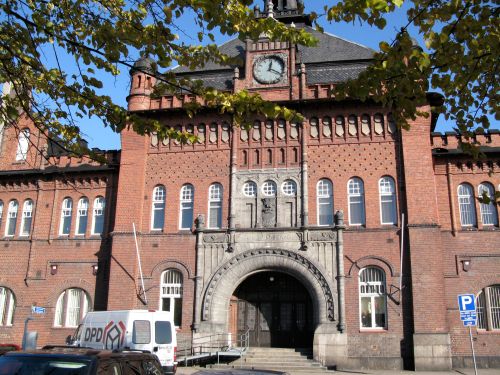 I took overland transport all the way from Helsinki to London so I had quite a lot of time for reading and, thanks to wi-fi, even spent time online. So many different worlds to choose from. Very 21st century you might say, very globalization, this being online.
I took overland transport all the way from Helsinki to London so I had quite a lot of time for reading and, thanks to wi-fi, even spent time online. So many different worlds to choose from. Very 21st century you might say, very globalization, this being online.
Setting off from the Olympic Terminal (so named because it was built for Helsinki’s 1952 Olympics) I travelled Helsinki-Stockholm-Köbenhavn-Köln-Bruxelles-London. On the way I was reminded of how much there is here in this relatively small part of a very, very small continent.
It all made me think a lot about the invention of the nation-state, the short history of the passport, national styles of music, languages, local foods and propensities to say ‘var så god’, ‘danke’ and ‘pardon’ [no stereotypes, please, Ed.]. I kept coming back to the fact that mixtures and rubbings of shoulders and exchanges have been the order of the day for one heck of a long time around the Baltic and, of course, in Helsinki itself, which was a multilingual, cosmopolitan, outward-looking harbour town 100 years ago if not earlier. According to Kjell Westö’s fiction, the area around Malminkatu was even called Babel for the mix of languages heard there.
My grandmother (born 1903) spoke Finnish but also Russian, Swedish and English, the last three very badly. But she did use them all in her own way. Then there have been all those people for whom Tatar, Romani, Yiddish and possibly other langauges are the most fluent. My grandmother seemed quite nostalgic, I thought, for the days of many languages and the exoticism it suggested to her (she wasn’t PC!).
 Then at some point Helsinki perhaps turned away from the sea, and away from the places and people it had always connected it to (had other stuff to worry about, I suppose). And then Finns became famously similar to each other, most homogeneous country in Europe, sort of thing. For my father, the aforementioned Olympics meant seeing for the first time ever, a) black man and b) a full beard on a young man, and his first taste of Coca Cola, but I think he too assumed that multilingualism and different religions in a city were normal, even desirable qualities, and he was certainly keen on cultural exchange even through the darkest days of Finnish consensus politics.
Then at some point Helsinki perhaps turned away from the sea, and away from the places and people it had always connected it to (had other stuff to worry about, I suppose). And then Finns became famously similar to each other, most homogeneous country in Europe, sort of thing. For my father, the aforementioned Olympics meant seeing for the first time ever, a) black man and b) a full beard on a young man, and his first taste of Coca Cola, but I think he too assumed that multilingualism and different religions in a city were normal, even desirable qualities, and he was certainly keen on cultural exchange even through the darkest days of Finnish consensus politics.
Back to now or the week-end. On the boat, as I enjoyed a dinner of fish washed down with a glass of wine and the only time I saw the entertainment venue was early evening before it filled with its drag show.

And with nobody to talk to (the waiter seemed a bit surly, surprisingly) I read that marvellous free rag, Voima. An article on migrant workers at the EU HQ in Brussels asked why eurocrats don’t find it uncomfortable to have their needs catered to by an almost uniformly non-white catering staff and went on to a damning critique of migration policies and the European blue card, a vehicle for poaching highly qualified people to work underpaid in Europe.
When I got back online I discovered that the mainstream in Finland has waffled stupid about restricting immigrants, as if that “conversation” wasn’t already far enough gone. Facebook has groups trying to fight back with Finnish varieties of anti-racism and cosmpolitanism (and probably with less charitable groups too along with the cowardly and bilious racist parts of the blogosphere). Interestingly, the Finnish-language HS.fi article on the SDP spokesman’s wishes to keep out migrant labour, was illustrated with a picture of a building site. (English article here).
Depressing! But to stop this post getting too worthy or too long, and to try and loop things back somehow to the built environment, I’ll just add a couple of links to other news stories, about Britain and Dubai, which demonstrate that the mainstream is happy with racist commentary here too, and that cheap labour and double-standards are a widespread contemporary phenomenon. Not, I hasten to add, that this makes the Finnish gits’ comments any less worrying.




 People I know boycott Helsingin Sanomat for all sorts of reasons. But it’s been the mouthpiece of the mainstream for 120 years, even back when
People I know boycott Helsingin Sanomat for all sorts of reasons. But it’s been the mouthpiece of the mainstream for 120 years, even back when 
 One can’t help thinking that a city’s cemeteries say something about its cosmpolitanism. Here, Russian orthodox graves in Hietaniemi.
One can’t help thinking that a city’s cemeteries say something about its cosmpolitanism. Here, Russian orthodox graves in Hietaniemi.

